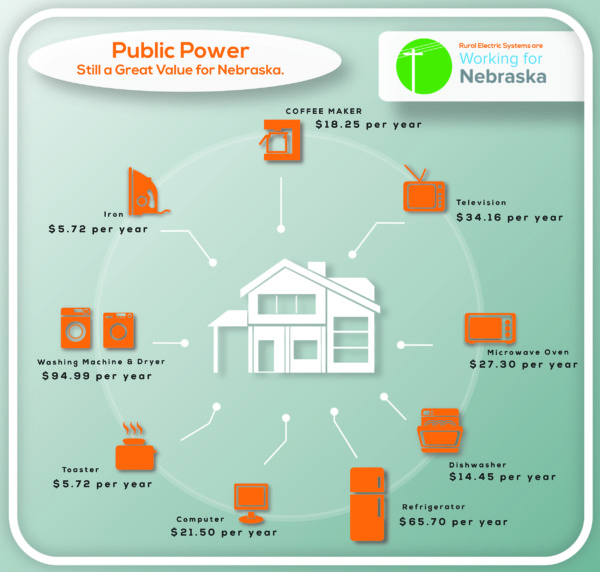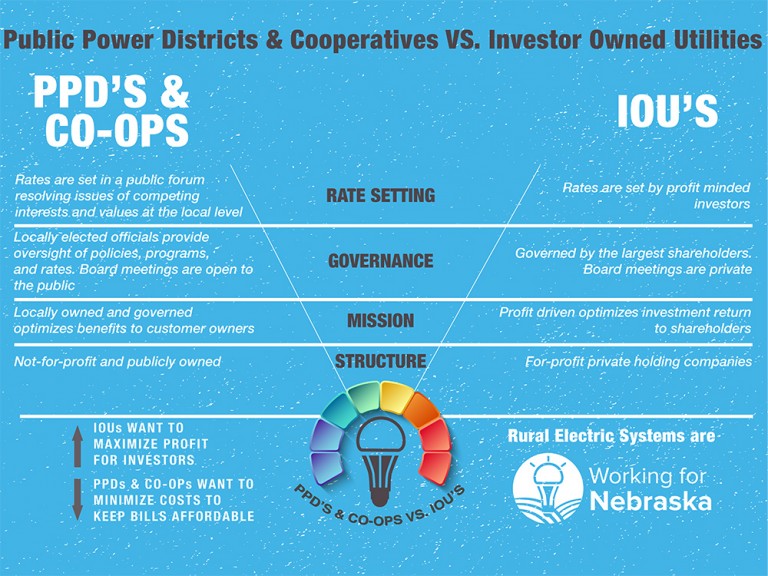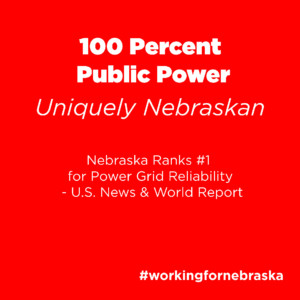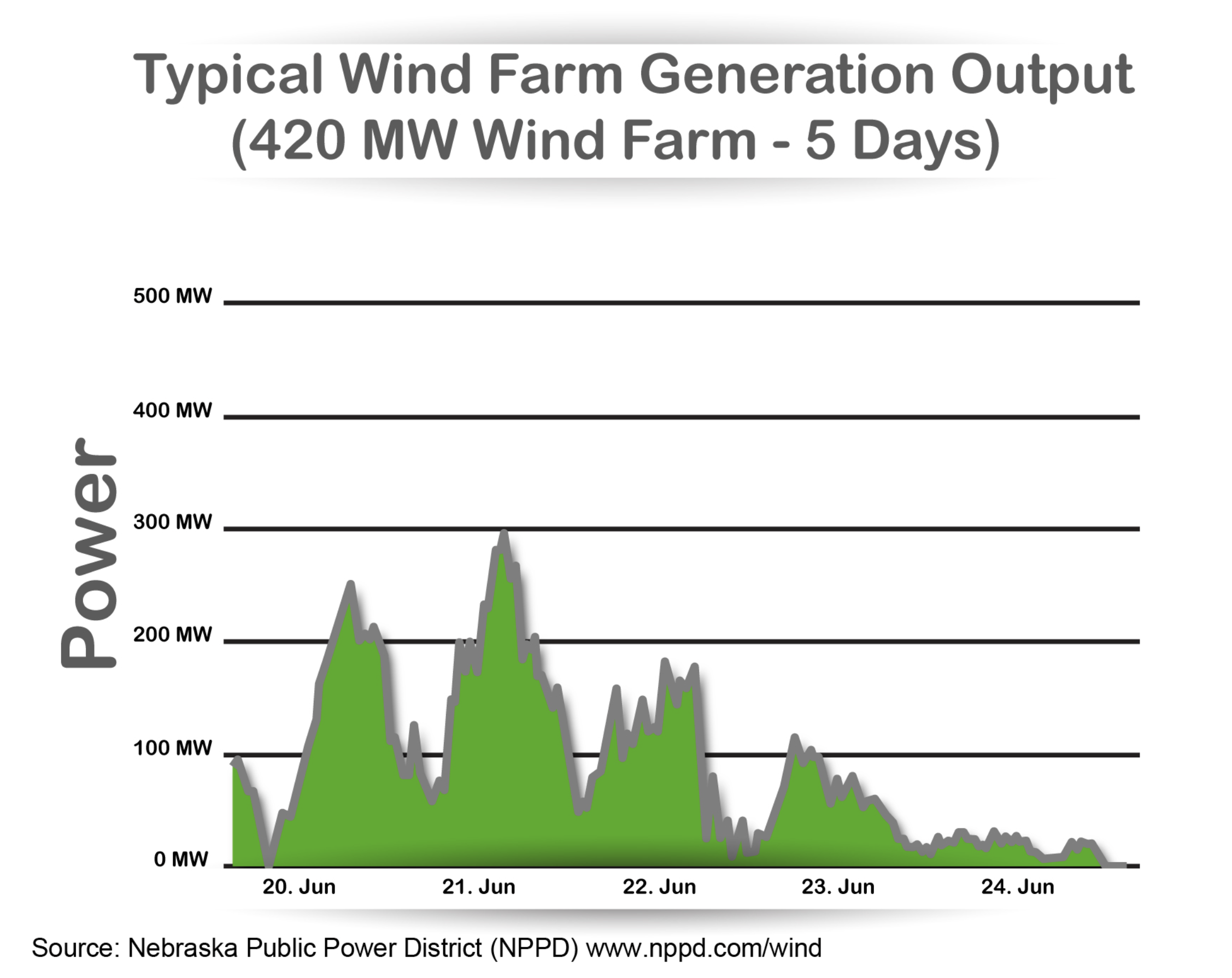Over the years, NREA’s mission has evolved to include a broad range of services to assist our member-systems as they face the many challenges of providing low-cost, reliable electric service to the sparsely populated regions of Nebraska. Today, the quality of electric service in even the most remote areas of the state equals or exceeds the electric service available in our largest communities. This achievement continues to be a source of pride for the directors, managers, and employees of our member-systems. Nebraska’s rural electric leaders will continue to be guided by their customer’s desire for safe, reliable, high-quality electric service at affordable rates. Nebraska’s rural electric member-systems are Working for Nebraska today, and we are confident that Nebraskans will continue to see the value in maintaining their locally-owned, controlled, and operated rural public power districts and electric cooperatives.
Low electric rates benefit all Nebraskans. Here, a homeowner can meet all of their electric needs for about $3.45 per day. This is less than the cost of a drive-thru meal to keep your home at a comfortable temperature, your lights on, and your appliances running. Nation-wide, Nebraska’s electric rates are 20 percent below the national average, and we rank in the top 15 among all states for the lowest electric rates.
At a time when prices on everything are climbing, public power remains a great value for Nebraskans. In fact, since 1936 electric rates in Nebraska have only gone up five cents per kilowatt hour on average.
Just one nickel’s change since the Great Depression and the beginning of the Rural Electrification Program which brought electricity to Nebraska’s most rural areas. Infrastructure upgrades, rising fuel prices, and federal regulation are all driving forces in increasing electric rates. To keep rates as low as possible, rural public power providers work diligently to keep overhead costs at a minimum. In fact, Nebraska’s rural electric systems employ just one individual for every 239 customers. Nearly 70 percent of your electric bill is the wholesale cost of power to rural power districts. This means the delivery of electricity and all of the work necessary to keep your lights on only makes up about 30 percent of your monthly charges.
As not-for-profit electric utilities, Nebraska’s rural electric systems hold a distinct competitive advantage among other states when it comes to the rates you pay for electric service. Our rates are cost-based, there are no profits built into your electric bill. There are no out-of-state profit-seeking shareholders making decisions about the rates you will pay for electricity. We answer to you. Our focus is simply delivering an affordable and reliable product safely to you, period. Nebraska’s public power model has served us well, and the value of public power is apparent in every small town across the state. From the jobs provided and taxes paid to the rural economy to the community service projects our rural electric member-systems perform;


Local control is one of the greatest benefits of Nebraska’s all public power model. In 1935, when rural electric systems began organizing in rural Nebraska, only about seven percent of Nebraska’s farms had access to electrical service. Investor Owned Utilities (IOU’s) saw no profit in delivering electricity to rural America. By 1958, 95 percent of Nebraska’s rural farms were receiving power. This transformation occurred when rural farmers, without access to the power market, came together to develop electric cooperatives and public power districts. The decisions governing these electric utilities were made, and continue to be made today, by member-owners and locally elected board members. There are no majority shareholders making decisions that will ensure the greatest profits, only local individuals that receive the same level of service as their constituents.
With local control also comes access. Unlike profit driven shareholders controlling an IOU, public power districts and electric cooperatives are governed by board members that are publicly elected. In a rural power district, this means you probably know the board member representing you and you know how to reach them with any concerns you may have. In addition, public power districts are required to comply with the Open Meetings Act which gives us all access to these meetings and the public information they discuss.
Local control means your public power utility knows you and has deep roots in your community. Governing board members have a stake in every decision they make and a sincere interest in the local economy. Every year Nebraska’s public power systems, including NREA’s member-systems, pay more than $100 million in taxes or in-lieu of tax payments in the communities they serve, and employ more than 6,000 Nebraskans across the state, many of these in rural Nebraska.
LOCAL CONTROL STRENGTHENS CUSTOMER SERVICE, PROMOTES A CULTURE OF SAFETY, INCREASES COMMUNICATION BETWEEN THE ELECTRIC UTILITY AND ITS CUSTOMERS AND IS JUST ONE MORE WAY NEBRASKA’S RURAL ELECTRIC MEMBER-SYSTEMS ARE WORKING FOR NEBRASKA.

Reliable electric service to our homes and businesses is a luxury we often take for granted. Unfortunately, we may not think about how important a reliable energy supply is to us until we have to go without it, like during a severe storm. It is in these times that utility employees work tirelessly to restore electricity to your home or business.
Where does your electricity come from? Although some may answer “the light switch,” for Nebraska’s public power providers the answer is a complex system of transmission and distribution lines and a generation mix stemming from multiple resources.
Electricity travels from its point of generation through electrical lines at the speed of light into your home. As a result, when you flip that light switch the lights come on instantaneously. The state’s electric providers operate load control centers where they monitor electric demand and relay messages to power plants telling them to increase or decrease generation, to match consumer demand at any given moment.
Currently, a technically feasible and economical means to store large amounts of electricity is not widely available. Battery storage capable of storing large amounts of electricity can be very costly. This means that in order for you to have power, a generator has to be running the moment you turn on your light switch.
This also means that reliable generation resources are necessary for reliable electric service.
Generation resources like, coal, nuclear, natural gas, or hydroelectric power are baseload resources which run continuously and can be controlled to meet load demands. Variable resources like wind and solar, however, rely on environmental conditions which can be hard to reliably predict, especially in Nebraska. As wind speeds vary or cloud cover changes, the electric output from these renewable generation resources can fluctuate dramatically and in an unpredictable manner. This complicates an already difficult load-balancing process.
As these fluctuations occur, baseload generation resources have to be available so your electric service remains constant. Unfortunately, most baseload power plants were not built to be continuously ramped up and down. Unlike your light switch, they cannot be turned on and off at a moment’s notice.
Nebraska’s energy experts are managing the demands of a complex electric grid while responsibly increasing the use of environmentally friendly renewable energy resources and doing so with fewer outages than our neighboring states.
RELIABLE POWER IS JUST ONE MORE WAY NEBRASKA’S RURAL ELECTRIC SYSTEMS ARE WORKING FOR NEBRASKA.


Did you know that more than 30 percent of Nebraska’s electricity comes from non-carbon emitting resources? Hydroelectric and nuclear energy, in addition to other renewable energy resources, help Nebraska to average more than 30 percent fewer carbon emissions than our neighboring states. Only South Dakota with an abundant supply of hydroelectric and natural gas generation has lower carbon emissions.
Long-term resource planning has allowed Nebraska’s public power systems to be good stewards of the environment while at the same time taking advantage of less costly energy generation resources. It is true that Nebraska’s wind energy potential is quite good. Of the 24 states that have developed more wind energy than Nebraska however, only nine have fewer carbon emissions per megawatt hour of energy produced.
Federal regulations have a direct and significant impact on the costs of electricity. Electric generators spend tens of millions of dollars complying with emission regulations governing sulfur dioxide (SO2), nitrogen oxide (NOx), mercury, and particulate emissions. In addition the Environmental Protection Agency (EPA) has proposed rules governing the carbon emissions of new and existing power plants. These regulations will continue to be a driving force in the increase of electric rates.
Nebraska’s rural electric systems are working hard to strike a balance between environmental responsibility, low-cost, and a reliable electric supply. To achieve this balance we need long-term statewide planning by engineers and operational experts familiar with the electric industry and whose job it is to ensure reliable electric service does not suffer. To understand this complicated issue, we must separate the rhetoric from the reality of power delivery. We need to have an open and honest discussion about protecting the integrity of our electrical system and keeping rates affordable while continuing to pursue the development of new and cleaner generation resources.
AN ENVIRONMENTALLY RESPONSIBLE ELECTRIC SUPPLY IS JUST ONE MORE WAY NEBRASKA’S RURAL ELECTRIC SYSTEMS ARE WORKING FOR NEBRASKA.

Local Control Videos
Local Control - Short version
Local Control - Long version
Reliability Videos
Reliability - Short version
Reliability - Long version
Affordability Videos
Affordability - Short version
Affordability - Long version
To Serve You
To Serve You - Short Version
To Serve You - Long Version

